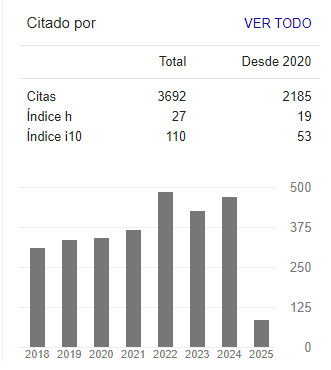
DOI:
https://doi.org/10.14483/23448393.21930Published:
2025-03-30Issue:
Vol. 30 No. 1 (2025): January-AprilSection:
Computational IntelligenceDeep Learning and Time Series for the Prediction of Monthly Precipitation. A Case Study in the Department of Boyacá, Colombia
Aprendizaje profundo y series temporales para la Predicción de la Precipitación Mensual. Estudio de caso: Departamento de Boyacá-Colombia
Keywords:
deep learning, neural networks, LSTM, ConvLSTM, time series (en).Keywords:
aprendizaje profundo, redes neuronales, LSTM, ConvLSTM, series temporales (es).Downloads
Abstract (en)
Context: This paper proposes a method for the prediction of monthly precipitation in the department of Boyacá using models based on deep neural networks (DNNs). These approaches have achieved significant improvements in prediction accuracy when compared to traditional methods.
Method: Data with a spatial resolution of 0.5° were extracted from CHIRPS 2.0 and subsequently preprocessed for the implementation of two approaches based on recurrent neural networks (RNNs) with long short-term memory (LSTM) and ConvLSTM architectures, aiming to provide accurate predictions of monthly precipitation in the studied region.
Objectives: The goal of this time series analysis is to predict monthly precipitation and develop accurate models that can forecast future rainfall patterns based on historical data. This aids in water resource management and agricultural planning, as well as in mitigating the impacts of droughts or floods.
Results: According to the results obtained, the LSTM model stands out for its robustness in terms of performance metrics, such as a lower mean squared error, a lower root mean squared error, and a coefficient of determination closer to 1. This demonstrates its higher accuracy compared to the ConvLSTM model.
Conclusions: Deep learning models, especially RNNs with LSTM, are effective tools for predicting crucial climate data.
Abstract (es)
Contexto: Este trabajo propone un método para la predicción de la precipitación mensual en el departamento de Boyacá utilizando modelos basados en redes neuronales profundas (DNNs). Estos enfoques han logrado mejoras significativas en la precisión de la predicción en comparación con los métodos tradicionales.
Método: Datos con una resolución espacial de 0.5° fueron extraídos de CHIRPS 2.0 y posteriormente preprocesados para la implementación de aproximaciones basadas en redes neuronales recurrentes (RNNs) con memoria de largo plazo (LSTM) y ConvLSTM para proporcionar predicciones precisas de precipitación. mensual en la región.
Objetovos: El objetivo de este análisis de series temporales es predecir la precipitación mensual y desarrollar modelos precisos que pronostiquen los patrones de precipitación futuros basándose en datos históricos. Esto contribuye a la gestión de los recursos hídricos, la planificación agrícola y la mitigación de los efectos de sequías o inundaciones.
Resultados: Los resultados obtenidos muestran que el modelo LSTM se destaca por su robustez en términos de métricas de rendimiento, tales como un menor error cuadrático medio, una menor raíz del error cuadrático medio y un coeficiente de determinación más cercano a 1. Esto demuestra su mayor precisión en comparación con el modelo ConvLSTM.
Conclusiones: Los modelos de aprendizaje profundo, especialmente los modelos RNN con LSTM, son herramientas eficaces para predecir datos climáticos cruciales.
References
C. E. González Orozco, M. Porcel, D. F. Alzate Velásquez, and J. O. Orduz Rodríguez, "Extreme climate variability weakens a major tropical agricultural hub," Ecol. Ind., vol. 111, art. 106015, Apr. 2020. https://doi.org/10.1016/j.ecolind.2019.106015
H. Tarwani, Sh. Patel and P. Goel, " Deep learning approach for weather classification using pre-trained convolutional neural networks," Procedia Computer Science., vol. 252, no. 3, pp. 136-145, 2025. https://doi.org/10.1016/j.procs.2024.12.015
D.A. Moreno Gaona, M.E. Morales Puentes, J.E Gil Nova, and J.D Mercado Gómez, " Structure of bryophyte communities in the paramo complexes of Boyacá-Colombia," Revista de Biología Tropical, vol 71, no. 1, pp. 1-13, 2023. https://doi.org/10.15517/rev.biol.trop..v71i1.53584
J. C. Valderrama Balaguera, H. F. Castro Silva, and C. A. Dávila Carrillo, " Pronósticos de variables climatológicas mediante los modelos de punto de cambio y Holt-Winters," Mundo FESC, vol. 11(S2), pp. 337-352, 2021. https://doi.org/10.61799/2216-0388.986
F. Rezaei Aderyani, S. Jamshid Mousavi, F. Jafari, "Short-term rainfall forecasting using machine learning-based approaches of PSO-SVR, LSTM and CNN," Journal of Hydrology., vol. 614, pp. 789-805, 2022. https://doi.org/10.1016/j.jhydrol.2022.128463
E. Morales Rojas, E. A. Díaz Ortiz, L.M. García, and M.E. Milla Pino, "Pronóstico de precipitaciones mensuales: Un estudio de caso en las comunidades nativas del Perú," Revista Cientifica Pakamuros, vol. 9, no. 3, pp. 71-85, 2021. https://doi.org/10.37787/13azmg02
D. M. Herrera Posada and E. Aristizábal, "Artificial intelligence and machine learning model for the spatial and temporal prediction of drought events in the department of Magdalena, Colombia," INGE CUC, vol. 18, no. 2, pp. 249-265, 2022. https://doi.org/10.17981/ingecuc.18.2.2022.20
B. Zhao, H. Lu, S. Chen, J. Liu, and D. Wu, "Convolutional neural networks for time series classification," Journal of Systems Engineering and Electronics, vol. 28, no 1, pp. 162-169, 2017. https://doi.org/10.21629/JSEE.2017.01.18
C. Wang, G.Tang, W. Xiong, Z. Ma, S. Zhu, "Infrared precipitation estimation using convolutional neural network for FengYun satellites," Journal of Hydrology., vol. 603, pp. 1-12, 2022. https://doi.org/10.1016/j.jhydrol.2021.127113
A. Fahim, Q. Tan, M. Mazzi, Md. Sahabuddin, B. Naz and S. Ullah Bazai. Hybrid LSTM Self-Attention Mechanism Model for Forecasting the Reform of Scientific Research in Morocco,” Computational Intelligence and Neuroscience., vol. 2021, pp. 1-14, 2021. https://doi.org/10.1155/2021/6689204
T. Nan, W. Cao, Z. Wang, Y. Gao, L. Zhao, X. Sun, and J. Na, "Evaluation of shallow groundwater dynamics after water supplement in North China Plain based on attention-GRU model," J. Hydrol., vol. 625, pp. 128-145, 2023. https://doi.org/10.1016/j.jhydrol.2023.130085
CHIRPS, "data.chc.ucsb.edu," [Online]. Available: https://data.chc.ucsb.edu/products/CHIRPS-2.0/global_daily/netcdf/p05/
Y. E. D. Prieto, "Rainfall data for the department of Boyacá," Kaggle, 2023. [Online]: Available: https://www.kaggle.com/datasets/estebanduarte/rainfall-data-for-the-department-of-boyaca
How to Cite
APA
ACM
ACS
ABNT
Chicago
Harvard
IEEE
MLA
Turabian
Vancouver
Download Citation
License
Copyright (c) 2025 Yesid Esteban Duarte, Marco Javier Suárez Barón, Oscar Javier García Cabrejo, César Augusto Jaramillo Acevedo, Carlos Augusto Meneses Escobar

This work is licensed under a Creative Commons Attribution-NonCommercial-ShareAlike 4.0 International License.
From the edition of the V23N3 of year 2018 forward, the Creative Commons License "Attribution-Non-Commercial - No Derivative Works " is changed to the following:
Attribution - Non-Commercial - Share the same: this license allows others to distribute, remix, retouch, and create from your work in a non-commercial way, as long as they give you credit and license their new creations under the same conditions.




2.jpg)










